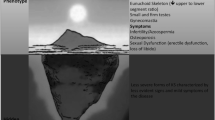Abstract
First described in 1983, Woodhouse-Sakati syndrome (WSS) is a rare autosomal recessive genetic disorder that leads to a spectrum of hypogonadal symptoms in adolescence. The responsible gene, DCAF17 located on chromosome 2q31.1, was discovered in 2008 and to date nine mutations have been reported in the literature. The aim of the study was to review WSS descriptively in the light of new case reports with focus on endocrine features. Phenotypic description of three patients (two females, one male) with WSS followed in the Endocrinology Department of the University Hospital of Nancy, France, and exhaustive review of the literature using the PUBMED database were performed. Of 72 patients from 29 families with documented WSS who were identified, 39 had undergone genetic testing. WSS was invariably associated with hypogonadism, decreased IGF1 and frontotemporal alopecia starting in childhood. In addition to this triad, some patients exhibited intellectual disabilities of varying severity (87 %), bilateral deafness (76 %), cervicofacial dystonia and limb pain (42 % of cases, rising to 89 % after 25 years) and diabetes (66 %, rising to 96 % after 25 years). The pathophysiology of WSS remains unclear.

Similar content being viewed by others
Abbreviations
- AMH:
-
Anti-Mullerian hormone
- MRI:
-
Magnetic resonance imaging
- WSS:
-
Woodhouse-Sakati syndrome
References
Alazami AM, Al-Saif A, Al-Semari A et al (2008) Mutations in C2orf37, encoding a nucleolar protein, cause hypogonadism, alopecia, diabetes mellitus, mental retardation, and extrapyramidal syndrome. Am J Hum Genet 83(6):684–691
Woodhouse NJ, Sakati NA (1983) A syndrome of hypogonadism, alopecia, diabetes mellitus, mental retardation, deafness, and ECG abnormalities. J Med Genet 20(3):216–219
Oerter KE, Friedman TC, Anderson HC, Cassorla FG (1992) Familial syndrome of endocrine and neuroectodermal abnormalities. Am J Med Genet 44(4):487–491
Devriendt K, Legius E, Fryns JP (1996) Progressive extrapyramidal disorder with primary hypogonadism and alopecia in sibs: a new syndrome? Am J Med Genet 62(1):54–57
Al-Semari A, Bohlega S (2007) Autosomal-recessive syndrome with alopecia, hypogonadism, progressive extra-pyramidal disorder, white matter disease, sensory neural deafness, diabetes mellitus, and low IGF1. Am J Med Genet A 143(2):149–160
Alazami AM, Schneider SA, Bonneau D et al (2010) C2orf37 mutational spectrum in Woodhouse-Sakati syndrome patients. Clin Genet 78(6):585–590
Medica I, Sepcić J, Peterlin B (2007) Woodhouse-Sakati syndrome: case report and symptoms review. Genet Couns 18(2):227–231
Schneider SA, Bhatia KP (2008) Dystonia in the Woodhouse Sakati syndrome: a new family and literature review. Mov Disord 23(4):592–596
Koshy G, Danda S, Thomas N, Mathews V, Viswanathan V (2008) Three siblings with Woodhouse-Sakati syndrome in an Indian family. Clin Dysmorphol 17(1):57–60
Rachmiel M, Bistritzer T, Hershkoviz E, Khahil A, Epstein O, Parvari R (2011) Woodhouse-Sakati syndrome in an Israeli-Arab family presenting with youth-onset diabetes mellitus and delayed puberty. Horm Res Paediatr. 75(5):362–366
Ben-Omran T, Ali R, Almureikhi M et al (2011) Phenotypic heterogeneity in Woodhouse-Sakati syndrome: two new families with a mutation in the C2orf37 gene. Am J Med Genet A. 155A(11):2647–2653
Habib R, Basit S, Khan S, Khan MN, Ahmad W (2011) A novel splice site mutation in gene C2orf37 underlying Woodhouse-Sakati syndrome (WSS) in a consanguineous family of Pakistani origin. Gene 490(1–2):26–31
Steindl K, Alazami AM, Bhatia KP et al (2010) A novel C2orf37 mutation causes the first Italian cases of Woodhouse Sakati syndrome. Clin Genet 78(6):594–597
Al-Awadi SA, Farag TI, Teebi AS et al (1985) Primary hypogonadism and partial alopecia in three sibs with Müllerian hypoplasia in the affected females. Am J Med Genet 22(3):619–622
Crandall BF, Samec L, Sparkes RS, Wright SW (1973) A familial syndrome of deafness, alopecia, and hypogonadism. J Pediatr 82(3):461–465
Al-Swailem SA, Al-Assiri AA, Al-Torbak AA (2006) Woodhouse Sakati syndrome associated with bilateral keratoconus. Br J Ophthalmol 90(1):116–117
Laron Z (2004) Laron syndrome (primary growth hormone resistance or insensitivity): the personal experience 1958–2003. J Clin Endocrinol Metab 89(3):1031–1044
Capalbo D, Melis D, De Martino L et al (2012) Noonan-like syndrome with loose anagen hair associated with growth hormone insensitivity and atypical neurological manifestations. Am J Med Genet A. 158A(4):856–860
Chowen JA, Frago LM, Argente J (2004) The regulation of GH secretion by sex steroids. Eur J Endocrinol 151(Suppl 3):U95–U100
Woods KA, Camacho-Hubner C, Clark AJL, Savage MO (1996) Intrauterine growth retardation and postnatal growth failure associated with deletion of insulin-like growth factor 1 gene. New Engl J Med. 355:1363–1367
Bakalov VK, Gutin L, Cheng CM et al (2012) Autoimmune disorders in women with turner syndrome and women with karyotypically normal primary ovarian insufficiency. J Autoimmun 38(4):315–321
Schmidt F, Kapellen TM, Wiegand S et al (2012) Diabetes mellitus in children and adolescents with genetic syndromes. Exp Clin Endocrinol Diabetes 120(10):579–585
Pierce SB, Chisholm KM, Lynch ED et al (2011) Mutations in mitochondrial histidyl tRNA synthetase HARS2 cause ovarian dysgenesis and sensorineural hearing loss of Perrault syndrome. Proc Natl Acad Sci USA 108(16):6543–6548
Spiegel R, Shalev SA, Adawi A, Sprecher E, Tenenbaum-Rakover Y (2010) ANE syndrome caused by mutated RBM28 gene: a novel etiology of combined pituitary hormone deficiency. Eur J Endocrinol 162(6):1021–1025
Andersen JS, Lam YW, Leung AK et al (2005) Nucleolar proteome dynamics. Nature 433(7021):77–83
Conflict of interest
The authors M. Agopiantz, P. Corbonnois, A. Sorlin, C. Bonnet, M. Klein, N. Hubert, V. Pascal-Vigneron, P. Jonveaux, T. Cuny, B. Leheup, and G. Weryha declare that they have no conflict of interest.
Author information
Authors and Affiliations
Corresponding author
Rights and permissions
About this article
Cite this article
Agopiantz, M., Corbonnois, P., Sorlin, A. et al. Endocrine disorders in Woodhouse-Sakati syndrome: a systematic review of the literature. J Endocrinol Invest 37, 1–7 (2014). https://doi.org/10.1007/s40618-013-0001-5
Received:
Accepted:
Published:
Issue Date:
DOI: https://doi.org/10.1007/s40618-013-0001-5




